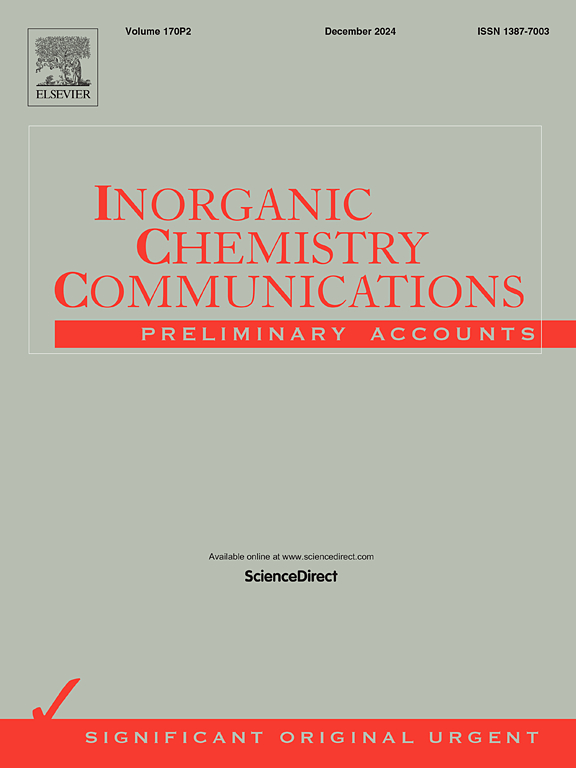揭示ZnO和Ag@ZnO纳米粒子的协同作用:抗癌、抗炎、抗氧化和抗菌性能的体外研究
IF 4.4
3区 化学
Q1 CHEMISTRY, INORGANIC & NUCLEAR
引用次数: 0
摘要
本研究利用一种环境友好的方法,利用苍耳叶提取物生产氧化锌和Ag@ZnO纳米颗粒。氧化锌和银纳米颗粒在许多行业中都有广泛的应用,包括抗真菌、抗氧化、抗菌、抗炎和抗癌等生物活性。因此,在本研究中,我们将银掺杂到氧化锌上以增强其生物活性。采用紫外-可见光谱(UV-vis)、场发射扫描电子显微镜(FESEM)、x射线衍射(XRD)、透射电子显微镜(TEM)和傅里叶变换红外光谱(FT-IR)等多种分析方法研究了ZnO和Ag@ZnO纳米颗粒的结构、形貌和光学性质。Ag@ZnO和ZnO纳米颗粒的抗菌研究表明,它们对金黄色葡萄球菌和大肠杆菌都有特殊的抗菌效果。Ag@ZnO NPs浓度为1000µg/mL时,对革兰氏阳性(18±0.18 mm)和革兰氏阴性(23±0.63 mm)菌均有较好的抑制作用。抗炎实验结果表明,制备的Ag@ZnO和ZnO纳米颗粒对蛋白质变性具有显著的抑制作用。结果表明,在1000 μg/mL时,对Ag@ZnO和Ag@ZnO NPs的抑制率分别为94.34±0.08%、94.35±0.11%,对ZnO NPs的蛋白酶抑制率分别为94.34±0.08和90.78±0.07。研究了Ag@ZnO和ZnO纳米颗粒的抗氧化性能,发现它们具有较强的抗氧化效果。在1000µg/mL时,Ag@ZnO和ZnO NPs的回收率分别为82.04±0.07%和74.29±0.04%。细胞毒活性表明,在512 mg mL−1浓度下,Ag@ZnO(20.743±0.086%)和ZnO(25.134±0.065%)纳米颗粒对MCF7细胞系表现出显著的细胞毒作用,并呈浓度依赖性,显示出其作为乳腺癌治疗剂的潜力。本文章由计算机程序翻译,如有差异,请以英文原文为准。

Unraveling the Synergistic effects of ZnO and Ag@ZnO Nanoparticles: An in Vitro investigation of Anti-Cancer, Anti-Inflammatory, Antioxidant, and Antibacterial Properties
The present study utilizes an environmentally benign approach to produce ZnO and Ag@ZnO nanoparticles using Xanthium strumarium leaf extract. ZnO and Ag nanoparticles are recognized for their applications across numerous industries, including biological activities such as antifungal, antioxidant, antibacterial, anti-inflammatory, and anticancer properties. Consequently, in this study, we have doped silver onto zinc oxide to enhance its biological activity. Various analytical methodologies were employed to investigate the structure, morphology, and optical properties of ZnO and Ag@ZnO nanoparticles, including Ultraviolet–Visible (UV–vis) Spectroscopy, Field Emission Scanning Electron Microscopy (FESEM), X-ray Diffraction (XRD), Transmission Electron Microscopy (TEM), and Fourier Transform Infrared (FT-IR) Spectroscopy. The antibacterial investigation of Ag@ZnO and ZnO nanoparticles demonstrated their exceptional efficacy against both S. aureus and E. coli. The zone of inhibition for both gram-positive (18 ± 0.18 mm) and gram-negative (23 ± 0.63 mm) bacteria was better achieved by Ag@ZnO NPs at 1000 µg/mL. The outcomes of the anti-inflammatory assay demonstrated that produced Ag@ZnO and ZnO nanoparticles had significant inhibition properties against protein denaturation. It was found at 1000 μg/mL, the percentage inhibition of the protein denaturation (BSA) assay has shown 94.34 ± 0.08 % for Ag@ZnO, 94.35 ± 0.11 % for ZnO NPs and the proteinase inhibitory activity has shown 94.34 ± 0.08 for Ag@ZnO Nps, 90.78 ± 0.07 for ZnO NPs respectively. The antioxidant properties of Ag@ZnO and ZnO nanoparticles were assessed, revealing their enhanced antioxidant effectiveness. It was found to be 82.04 ± 0.07 % for Ag@ZnO, 74.29 ± 0.04 % for ZnO NPs at 1000 µg/mL, respectively. The cytotoxic activity revealed that, at a concentration of 512 mg mL−1, Ag@ZnO (20.743 ± 0.086 %) and ZnO (25.134 ± 0.065 %) nanoparticles exhibited significant cytotoxicity against the MCF7 cell line in a concentration-dependent manner, revealing their potential as therapeutic agents for breast cancer.
求助全文
通过发布文献求助,成功后即可免费获取论文全文。
去求助
来源期刊

Inorganic Chemistry Communications
化学-无机化学与核化学
CiteScore
5.50
自引率
7.90%
发文量
1013
审稿时长
53 days
期刊介绍:
Launched in January 1998, Inorganic Chemistry Communications is an international journal dedicated to the rapid publication of short communications in the major areas of inorganic, organometallic and supramolecular chemistry. Topics include synthetic and reaction chemistry, kinetics and mechanisms of reactions, bioinorganic chemistry, photochemistry and the use of metal and organometallic compounds in stoichiometric and catalytic synthesis or organic compounds.
 求助内容:
求助内容: 应助结果提醒方式:
应助结果提醒方式:


